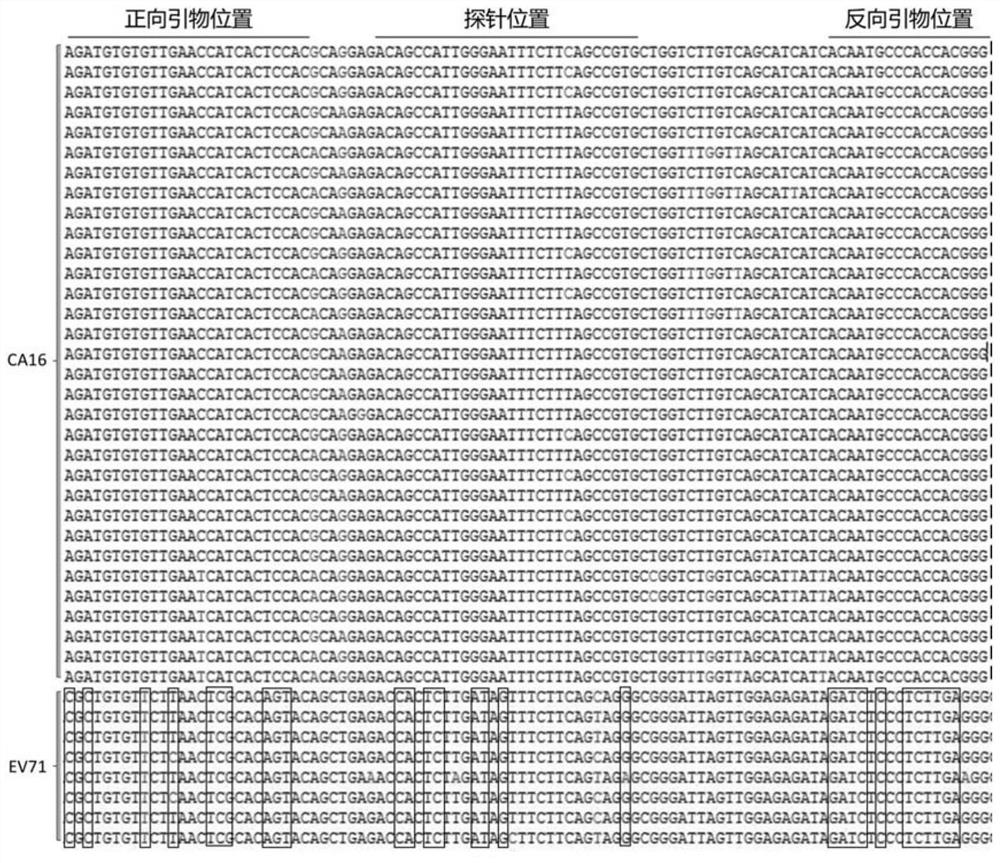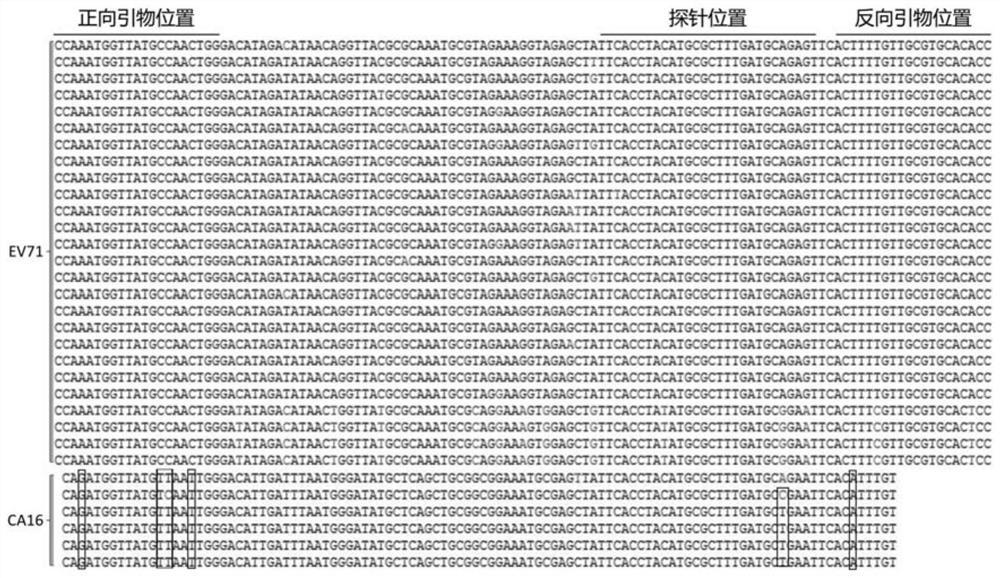Fluorescent RT-PCR detection reagent and method for coxsackievirus A16 and enterovirus 71
A technology of RT-PCR and coxsackie virus, applied in biochemical equipment and methods, DNA/RNA fragments, recombinant DNA technology, etc., can solve the problem of reducing reagent detection performance, liquid reagents cannot adapt to the application of grassroots detection institutions, and reagent failure Risks and increased costs of cold chain management
- Summary
- Abstract
- Description
- Claims
- Application Information
AI Technical Summary
Problems solved by technology
Method used
Image
Examples
Embodiment 1
[0043] Example 1. This example provides a design scheme of fluorescent RT-PCR primers and probes for detecting CA16 and EV71.
[0044] In the present invention, by analyzing the CA16 and EV71 nucleic acid sequence information in the public gene sequence database, selected figure 1 and figure 2 The nucleic acid sequences shown are respectively used as the detection target sequences of CA16 and EV71. Utilize the Primer Express V3.0 software to design the following primers for amplifying the target sequence and the probe sequences for detecting the target sequence:
[0045] The sequences of the specific forward primers of CA16 are SEQ ID No.1 (Tm=59.7°C) and SEQ ID No.2 (Tm=59.4°C), and the sequences of the reverse primers are SEQ ID No.3 (Tm=59.7°C ), the sequences of the probes are SEQ ID No.4 (Tm=68.8°C) and SEQ ID No.5 (Tm=69.6°C). The 5' end of the probe was modified with a fluorescent reporter group FAM, and the 3' end was modified with a fluorescent quencher group BHQ1...
Embodiment 2
[0049] Example 2: This example demonstrates that the CA16 and EV71 fluorescent RT-PCR detection reagents described in the present invention are made into freeze-dried reagents by vacuum freeze-drying technology.
[0050] Prepare CA16 and EV71 fluorescent RT-PCR liquid detection reagents according to the preferred components and contents described in Table 1, and divide them into 200 μl PCR eight-tube tubes according to 1 part / tube, then carry out vacuum freeze-drying, and the obtained CA16 and EV71 are freeze-dried The fluorescent RT-PCR detection reagent is white particles ( image 3 ). Add 23 μl of nuclease-free water to a reagent, shake slowly for 10 seconds, the reagent is completely dissolved, and the volume measured with a pipette gun is 25 μl, which shows that the volume of the reagent before reconstitution is equivalent to 2 μl. In order to prevent the reagents from getting wet and exposed, the CA16 and EV71 freeze-dried fluorescent RT-PCR detection reagents are first...
Embodiment 3
[0051] Example 3: This example demonstrates the detection effect of CA16 and EV71 nucleic acid positive reference products using the CA16 and EV71 freeze-dried fluorescent RT-PCR detection reagents of the present invention.
[0052] Carry out 10-fold serial dilution of the CA16 and EV71 nucleic acid positive reference substance mixture, mix 5 μl and 18 μl nuclease-free water for each concentration, and then add to 1 portion of CA16 and EV71 freeze-dried fluorescent RT-PCR prepared according to Example 2 In the detection reagent; 23 μl of nuclease-free water was used as a negative control. A reaction mixture with a volume of 25 μl was obtained, which was slowly oscillated to dissolve, centrifuged, and tested on a fluorescent PCR instrument. The reaction program was set according to Table 2. Each treatment was repeated 3 times.
[0053] Test results such as Figure 4 Shown, CA16 of the present invention and EV71 lyophilized fluorescent RT-PCR detection reagent are all positive...
PUM
| Property | Measurement | Unit |
|---|---|---|
| diameter | aaaaa | aaaaa |
Abstract
Description
Claims
Application Information
 Login to View More
Login to View More - R&D
- Intellectual Property
- Life Sciences
- Materials
- Tech Scout
- Unparalleled Data Quality
- Higher Quality Content
- 60% Fewer Hallucinations
Browse by: Latest US Patents, China's latest patents, Technical Efficacy Thesaurus, Application Domain, Technology Topic, Popular Technical Reports.
© 2025 PatSnap. All rights reserved.Legal|Privacy policy|Modern Slavery Act Transparency Statement|Sitemap|About US| Contact US: help@patsnap.com



